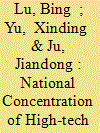| Srl | Item |
| 1 |
ID:
158907


|
|
|
|
|
| Summary/Abstract |
This paper comprehensively reviews China's openness since 1978 from three aspects: trade, foreign investment and global production sharing. We point out that the economic development of China is now standing at a historic turning point. Specifically, economic changes in China are discussed from four dimensions: (i) from China being a world assembly line to a world manufacturing powerhouse; (ii) from China being a world capital receiver to a world investor; (iii) from China being a world factory to a world market; and (iv) from the situation of “made in China” to “innovated in China.” At the same time, the global economic system has also reached a turning point. A “North America–Europe–Asia” tri‐polar system has formed, in which the USA, Germany and China, respectively, serve as the regional core economies.
|
|
|
|
|
|
|
|
|
|
|
|
|
|
|
|
| 2 |
ID:
190398


|
|
|
|
|
| Summary/Abstract |
Based on the product-country level trade data from 2004 to 2017, as well as the High-Tech Products Catalog from the US Census Bureau, this paper examines empirically the current phenomenon of “national concentration” in high-tech exports. The results show that the phenomenon of “national concentration” not only exists but also tends to be self-reinforcing. Compared with other products, the exports of high-tech products tend to be concentrated in certain countries, and this concentration trends were further strengthened after the global financial crisis of 2008–2009. The national concentration of R&D activities may be one of the important causes of the national concentration of high-tech products. This pattern remains robust when we further use the value-added export data and different definitions of high-tech products. We argue that the phenomenon of “national concentration” of high-tech exports may herald the arrival of the “Second Great Divergence” – the divergence between innovative and manufacturing activities – in the global economy.
|
|
|
|
|
|
|
|
|
|
|
|
|
|
|
|
| 3 |
ID:
167812


|
|
|
|
|
| Summary/Abstract |
How to promote capital account liberalization while preventing financial crises is a challenging task for policymakers. This study proposes a nonlinear (progressive) capital flow tax as a solution. We first demonstrate that the collateral requirement of international borrowing can give rise to multiple equilibria and self‐fulfilling financial crises. We then show that the crisis equilibrium characterized by large exchange rate depreciation, capital flight and welfare loss can be eliminated by imposing a nonlinear (progressive) tax scheme on capital outflows with the marginal tax rate increasing with the size of individual capital outflows. The implementation of such a tax scheme in China is also discussed.
|
|
|
|
|
|
|
|
|
|
|
|
|
|
|
|